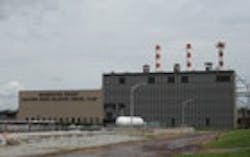Black & Veatch to Design Energy Recovery Project in Hartford, Conn.
Black & Veatch will design and oversee construction for one of the largest energy recovery projects of its kind on the U.S. East Coast for the Metropolitan District Commission (MDC) in Hartford, Conn.
“There is a growing interdependence between energy and water and the sustainable infrastructure applications needed for producing or treating both,” said Len C. Rodman, chairman, president and CEO of Black & Veatch. “When completed, the facility will convert renewable biosolids generated from wastewater treatment processing into power, significantly reducing the facility’s demand on the local area’s power grid and reducing its overall energy costs.”
Currently, biosolids produced at the 80-million-gal-per-day Hartford Water Pollution Control Facility, the largest of four wastewater treatment plants operated by the MDC, are burned in multiple hearth incinerators. Black & Veatch will implement necessary upgrades to the incinerators and processing system, as well as design an energy recovery facility that captures heat from the incinerators to produce steam. That steam will power a turbine and produce an estimated 1.5 megawatts of electricity per hour, approximately 40% of the facility’s annual electricity consumption.
“This project will draw on the expertise of our global workforce in biosolids, incineration facilities and power generation across our water and energy businesses,” said Dan McCarthy, president and CEO of Black & Veatch’s global water business. “By harnessing energy produced on site and utilizing it as a renewable energy source, the facility will remain an environmentally sound and socially responsible one with more flexibility and efficiency and less dependence on oil and other non-renewable energy sources.”
Two of the plant’s three incinerators were upgraded in 2001. By upgrading the third incinerator and bringing it online, the MDC will have flexibility and adequate redundancy to operate two incinerators at all times—the maximum number allowed by permitting requirements—and will therefore be able to maximize the use of the energy recovery facility.
This innovative conversion process creates opportunities for both water and energy utilities as energy is one of the highest operating costs associated with treating water and wastewater. From an energy utility perspective, the ability to maximize the use of energy recovered by these facilities helps reduce long-term energy demand.
Source: Black & Veatch
